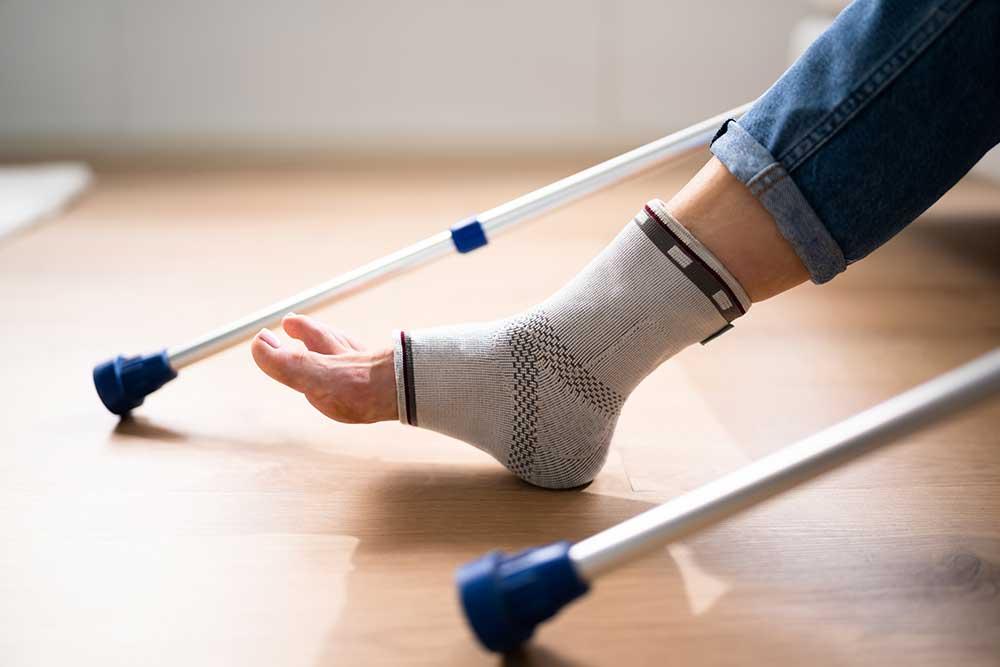The Difference Between a Sprain vs. Fracture

What are Sprains and Fractures?
What is a fracture? A fracture is simply a broken bone. A sprain is basically a ligament or tendon that has been stretched out, or maybe even torn. Sprains occur when the ligaments around your joints tear or is stretched too far. Sprains can happen when you fall. It can also be caused through sports.
For the average person, it can be difficult to tell whether they are suffering from a sprain or a fracture. Usually, they rely on a doctor in the emergency room to tell them what is going on, but x-rays can be extremely expensive. With the rising cost of health care, many people are not being treated in hopes that they only have a sprain.
But if the problem turns out to be a fracture, they develop more significant issues and extreme pain. By coming here, you have taken the initiative to take control of your health and your financial future.
Is that Horrible Pain in Your Ankle a Sprain or Fracture?
When you hurt your ankle, it can initially be difficult to determine whether you are suffering from a sprain or a fracture. There are a lot of ways you can determine what is going on inside your body, without spending $600 on medical tests, especially since, very often, you don’t even get a copy of your scans. Unfortunately, without knowing what is wrong, you cannot determine the right course of treatment.
If you are in tune with your body and pay careful attention to your own anatomy, you may be able to determine whether you have a sprain or a fracture. As you read the bullet points below, make sure to carefully evaluate each statement in comparison to your body.
- Is the pain in the soft, squishy tissue around the bone, or is it over the bone? If the pain is located in the soft tissue, there is a very high chance that you only have a sprain.
- Is the pain located over top of a bone, specifically the ankle bone? If the pain is located over a bone, there are no ligaments or tendons here. It is extremely likely that you have a fracture.
- Are you able to walk on it? If you are unable to walk on it because the pain is so severe, or it simply won’t hold your weight, there is a very high chance that you have a fracture. A sprain will be painful to walk on, but not unbearable.
Well That Isn’t Specific – What Else Should I Know?
Okay, if you are not familiar with human anatomy, there is a chance that the bullet list above did not help you much. However, there are ways to determine whether you are experiencing a sprain verses a fracture.
If you have injured your ankle, and it is difficult to determine whether it is a serious problem, you can follow the doctor’s rule of thumb. Watch the injury and follow the RICE method for between two and four days. What is the RICE method?
Rest – Avoid using the injured area as much as possible. If the injury is your ankle, try not to walk on it for these two to four days.
Ice – Ice the area. Wrap an ice pack in a small towel and apply it to the injury. Leave the ice on for 15 minutes, remove it for 15 minutes. Do this throughout the day to relieve the swelling and pain.
Compression – Wrap your ankle in an ace bandage to maintain joint stability. Compression can also help relieve swelling.
Elevate – Elevate the injury site at an angle that allows it to sit just above your heart. This will help to reduce swelling.
After two to four days, check the injury site. If the pain is still severe, you cannot utilize the area around the site, you see bruising (either black, blue, or purple), or blisters, you need to be seen by a doctor.
Signs and Symptoms
The signs and symptoms of a sprain will be different depending on the location of the injury, and how severe it is. However, here are the general symptoms experienced.
Sprains
Sprains can be extremely painful, and are easy to confuse as a break. Many times, they are more painful than a fracture, which has been confirmed by science. However, the symptoms of a sprain are usually:
- Pain around the injury area
- Swelling around the injury area
- Mild bruising around the area
- Limited range of motion in the joint that is affected
- At the exact time of injury, you may hear the sound of a pop in a joint. If you do not here one, you will feel one.
Strains
A strain can cause extreme pain, no matter where it is. However, these injuries are isolated to muscles tendons, and ligaments. It can happen anywhere, but is not isolated to areas with a joint. The symptoms of a strain include:
- Severe pain

- Rapid swelling
- Muscle spasms in the injury location, and surrounding muscles
- Limited range of motion in the muscle that is injured.
Fractures
The symptoms of a fractured bone may not always be obvious. Here are some of the symptoms to look for if you have an injury:
- Severe swelling over top of a bone.
- Bruising over top of a bone
- Deformity of the injured area
- Pain that increases when pressure is applied or the area is moved.
- Inability to use the injured limb
- Bone poking through the skin.
When You Should Go to the Emergency Room (ER)
Since it can be difficult to tell the difference between a fracture and a sprain, how do you know when to go to the emergency room or see your doctor? Here is a cheat sheet that lets you know exactly when you should go to the doctor immediately after an injury.
- Can you walk more than four steps? You can watch the injury and wait to see what happens.
- Can’t walk more than four steps without excruciating pain? You need to go to the emergency room.
- Is the injured location numb or tingling? If it is, you should go straight to the emergency room for treatment.
More Information on Fractures
The risk of having a fractured bone depends on a number of factors. It is extremely common in childhood to fracture a bone or two, and if a child is into sports, possibly more. Because of the pliability of a child’s bones, the condition is usually less severe than it is for adults and treatment is a lot less complicated. Older adults are also likely to suffer fractures frequently, this is because their bones are brittle and not as pliable as they are during more youthful times of your life.
There are a lot of different types of fractures, but doctors usually describe them as displaced, non-displaced, closed, and open fractures.
- Displaced – The edges of the break moved away from one another as it broke.
- Non-displaced – The bones remained in the same place and the bone cracked and they are still aligned.
- Open fracture – The bone broke through the skin as it snapped.
- Closed fracture – The bone did not puncture the skin.
- Greenstick fracture – the bone bent and the fracture did not complete. It is common in children.
- Transverse fracture – a break where a piece of the bone is at a right angle in comparison to the bone’s existing axis.
- Oblique fracture – The break is curved or sloping in appearance.
- Comminuted fracture – The bone shatters into multiple pieces.
- Buckled fracture – Impact fracture causing the bone to drive into itself fracturing on impact.
- Pathologic fracture – a fracture caused by weak bones.
- Stress fracture – a small, painful hairline crack in the bone.
Is Surgery Needed?
Most sprains and fractures are treated in a conservative manner and surgery is not needed. However, if there is a severe break that needs to be stabilized, surgery may be needed. If you have managed to watch your injury for a few days, chances are it is not that severe. The pain would have sent you straight to the emergency room when it occurred.
The only time surgery is required for a sprain is if the ligament or tendon is completely torn. In this case, it may need to be reattached surgically to prevent further damage, proper healing, and avoid long-term damage.




